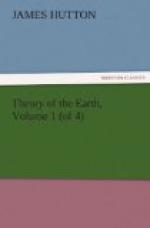At Jedburgh the schistus was vertical, and the strata horizontal; and there was interposed a compound bed of pudding-stone, formed of various water-worn bodies, the gravel of the schistus strata, and porphyries. Here again, though we have not a regular pudding-stone, we have that which corresponds to it, as having been the effect of similar circumstances. These are the fracture and detritus of the schistus, while the strata were deposited upon the broken ends of the schistus at the bottom of the sea. Most of the fragments of the schistus have their angles sharp; consequently, they had not travelled far, or been much worn by attrition. But more or less does not alter the nature of an operation; and the pudding-stone, which at Jedburgh is interposed between the vertical schistus and horizontal strata, is here properly represented by the included fragments of schistus in the inclined strata.
The line of this junction running, on the one hand, towards Fast Castle eastward, and, on the other, towards the head of Dunglass burn westward, our business was to pursue this object in those two different directions. But it was chiefly in the sea coast that was placed our expectations, having recollection of the great banks of gravel under which the strata are buried about Oldhamstocks, near which, from all appearances, the junction was to be expected.
Having taken boat at Dunglass burn, we set out to explore the coast; and, we observed the horizontal sand-stone turn up near the Pease burn, lifting towards the schistus. We found the junction of that schistus with the red sand-stone and marly strata on the shore and sea bank, at St. Helens, corresponding in general with what we had observed in the burns to the westward. But, at Siccar Point, we found a beautiful picture of this junction washed bare by the sea. The sand-stone strata are partly washed away, and partly remaining upon the ends of the vertical schistus; and, in many places, points of the schistus strata are seen standing up through among the sand-stone, the greatest part of which is worn away. Behind this again we have a natural section of those sand-stone strata, containing fragments of the schistus.
After this nothing appears but the schistus rocks, until sand-stone and marl again are found at Red-heugh above the vertical strata. From that bay to Fast Castle we had nothing to observe but the schistus, which is continued without interruption to St Abb’s Head. Beyond this, indeed, there appears to be something above the schistus; and great blocks of a red whin-stone or basaltes come down from the height and lie upon the shore; but we could not perceive distinctly how the upper mass is connected with the vertical schistus which is continued below.
Our attention was now directed to what we could observe with respect to the schisti, of which we had most beautiful views and most perfect sections. Here are two objects to be held in view, in making those observations; the original formation or stratification of the schisti, and the posterior operations by which the present state of things has been procured. We had remarkable examples for the illustration of both those subjects.




